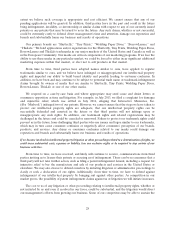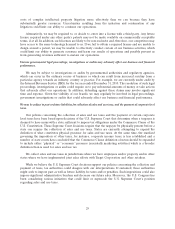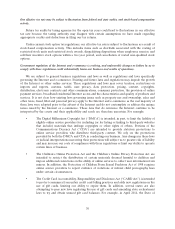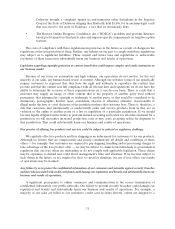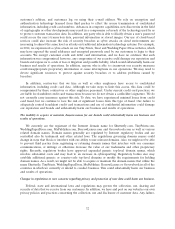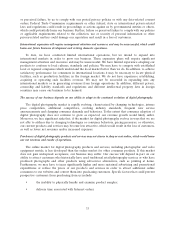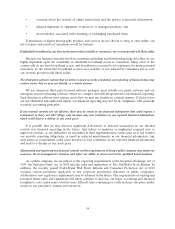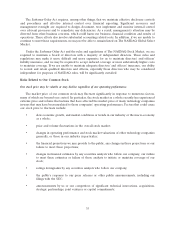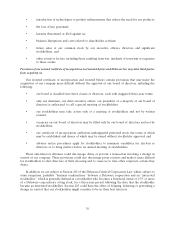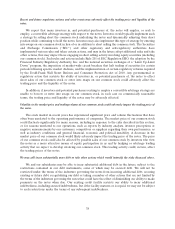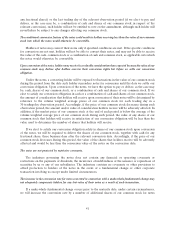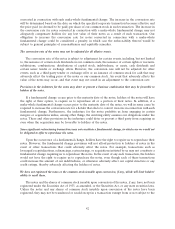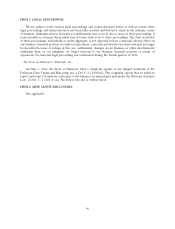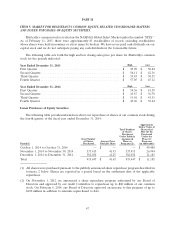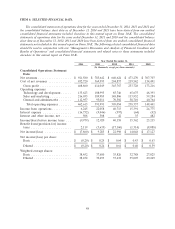Shutterfly 2014 Annual Report Download - page 39
Download and view the complete annual report
Please find page 39 of the 2014 Shutterfly annual report below. You can navigate through the pages in the report by either clicking on the pages listed below, or by using the keyword search tool below to find specific information within the annual report.Recent and future regulatory actions and other events may adversely affect the trading price and liquidity of the
notes.
We expect that many investors in, and potential purchasers of, the notes will employ, or seek to
employ, a convertible arbitrage strategy with respect to the notes. Investors would typically implement such
a strategy by selling short the common stock underlying the notes and dynamically adjusting their short
position while continuing to hold the notes. Investors may also implement this type of strategy by entering
into swaps on our common stock in lieu of or in addition to short selling the common stock. The Securities
and Exchange Commission (‘‘SEC’’) and other regulatory and self-regulatory authorities have
implemented various rules and taken certain actions, and may in the future adopt additional rules and take
other actions, that may impact those engaging in short selling activity involving equity securities (including
our common stock). Such rules and actions include Rule 201 of SEC Regulation SHO, the adoption by the
Financial Industry Regulatory Authority, Inc. and the national securities exchanges of a ‘‘Limit Up-Limit
Down’’ program, the imposition of market-wide circuit breakers that halt trading of securities for certain
periods following specific market declines, and the implementation of certain regulatory reforms required
by the Dodd-Frank Wall Street Reform and Consumer Protection Act of 2010. Any governmental or
regulatory action that restricts the ability of investors in, or potential purchasers of, the notes to effect
short sales of our common stock or enter into swaps on our common stock could adversely affect the
trading price and the liquidity of the notes.
In addition, if investors and potential purchasers seeking to employ a convertible arbitrage strategy are
unable to borrow or enter into swaps on our common stock, in each case on commercially reasonable
terms, the trading price and liquidity of the notes may be adversely affected.
Volatility in the market price and trading volume of our common stock could adversely impact the trading price of
the notes.
The stock market in recent years has experienced significant price and volume fluctuations that have
often been unrelated to the operating performance of companies. The market price of our common stock
could fluctuate significantly for many reasons, including in response to the risks described in this section,
or for reasons unrelated to our operations, such as reports by industry analysts, investor perceptions or
negative announcements by our customers, competitors or suppliers regarding their own performance, as
well as industry conditions and general financial, economic and political instability. A decrease in the
market price of our common stock would likely adversely impact the trading price of the notes. The price
of our common stock could also be affected by possible sales of our common stock by investors who view
the notes as a more attractive means of equity participation in us and by hedging or arbitrage trading
activity that we expect to develop involving our common stock. This trading activity could, in turn, affect
the trading prices of the notes.
We may still incur substantially more debt or take other actions which would intensify the risks discussed above.
We and our subsidiaries may be able to incur substantial additional debt in the future, subject to the
restrictions contained in our debt instruments, some of which may be secured debt. We will not be
restricted under the terms of the indenture governing the notes from incurring additional debt, securing
existing or future debt, recapitalizing our debt or taking a number of other actions that are not limited by
the terms of the indenture governing the notes that could have the effect of diminishing our ability to make
payments on the notes when due. Our existing credit facility restricts our ability to incur additional
indebtedness, including secured indebtedness, but if the facility matures or is repaid, we may not be subject
to such restrictions under the terms of any subsequent indebtedness.
38


